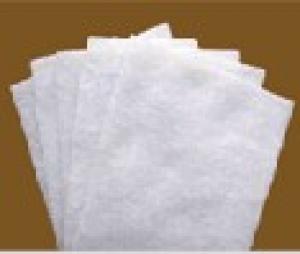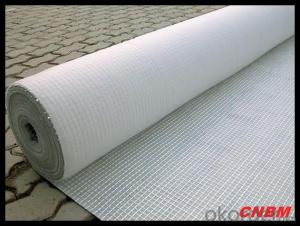Geotextil Para Que Sirve:Polypropylene Staple Fiber Needle Punched Geotextile
- Loading Port:
- Qingdao
- Payment Terms:
- TT OR LC
- Min Order Qty:
- 1 m²
- Supply Capability:
- 1000000 m²/month
OKorder Service Pledge
OKorder Financial Service
You Might Also Like
Products overview:
Polypropylene staple fiber needle-punched nonwoven geotextile is with high quality polypropylene short fiber as raw material, through carding web acupuncture. Single side or double side hot rolling also can according to requirements.
Performance characteristics:
Flexibility feld, acid and alkali resistance, corrosion resistance, aging resistance, high strength, size stability, soil can enhance the ability of resistance to deformation and the tensile strength, to improve the stability of the building structure, to improve the quality of soil, polypropylene staple fiber nonwoven fabric also has good air permeability and water permeability, make the water flow through, effectively intercept sand erosion, filter, isolation performance, can prevent the lower sandstone, mixed between soil and concrete, construction is convenient, etc.
Purpose:
1, staple fiber geotextile acupuncture can be used in water conservancy project: standard seawall, consideration, the river, the lake engineering; Reservoir reinforcement project; Wai tu reclamation engineering; Flood control and emergency rescue.
2, staple fiber geotextile acupuncture can be used to power plant engineering: plant engineering; Coal ash dam engineering; Hydropower station.
3, staple fiber geotextile acupuncture can be used for highway railway airport project; Soft ground reinforcement; Slope protection; Pavement reflection; Cracks and structure layer; Drainage system; Green barriers.
4, staple fiber geotextile acupuncture can be used in harbor engineering, port wharf engineering; Lock engineering; Channel regulation project.
Product specifications:
2 to 7 m, width:
G: 100 g - 800 - g/m2.
- Q: How do geotextiles help with reinforcement of geogrid retaining walls?
- Geotextiles help with the reinforcement of geogrid retaining walls by acting as a separator between the backfill materials and the geogrids. They prevent the fine particles in the backfill from clogging the geogrids, maintaining their effective functioning. Additionally, geotextiles distribute the load evenly across the geogrids, enhancing their strength and stability.
- Q: Mainly on the cement concrete laying asphalt overlay and deck pavement, a bit puzzled, sticky words and how to design more
- Can be set together, geotextile in the lower layer can play a good pull, the role of protection!
- Q: How do geotextiles help in preventing soil erosion on slopes?
- Geotextiles act as a barrier between soil and water, allowing for better drainage and filtration. They stabilize the soil, prevent particle movement, and reduce surface erosion by increasing the overall shear strength of the slope.
- Q: How do geotextiles improve the performance of dams?
- Geotextiles improve the performance of dams by providing reinforcement, filtration, and separation functions. They enhance the stability of the dam structure by preventing soil erosion, reducing seepage, and increasing the overall durability. Additionally, geotextiles help in maintaining proper water flow, preventing the clogging of drainage systems, and enhancing the overall efficiency and longevity of the dam.
- Q: How do geotextiles affect soil permeability?
- Geotextiles can improve or reduce soil permeability depending on the specific application and design. In some cases, geotextiles act as a filter, allowing water to pass through while trapping fine particles and preventing clogging. This can enhance soil permeability by preventing the formation of a dense layer that obstructs water flow. On the other hand, certain geotextiles can be designed to decrease soil permeability by acting as a barrier, preventing water from infiltrating or draining through the soil. Ultimately, the impact of geotextiles on soil permeability is determined by their purpose and the specific properties of the material used.
- Q: Can geotextiles be used in stormwater management systems?
- Yes, geotextiles can be used in stormwater management systems. Geotextiles are often used to enhance filtration and separation in stormwater management applications, helping to control erosion and retain sediment within the system. They can be used in various components of stormwater systems such as sediment basins, retention ponds, and biofiltration systems to improve their effectiveness and longevity.
- Q: How do geotextiles help with soil reinforcement in mechanically stabilized earth walls?
- Geotextiles help with soil reinforcement in mechanically stabilized earth walls by providing a strong and stable support system. They act as a barrier between the soil layers, preventing erosion and maintaining the integrity of the wall. The geotextiles distribute the load of the soil evenly, reducing the potential for settlement or failure. Additionally, they enhance the overall stability of the structure by increasing the friction between the soil layers, improving the resistance to lateral forces.
- Q: How do geotextiles improve the performance of sports fields?
- Geotextiles improve the performance of sports fields by providing stability, drainage, and reinforcement. They help prevent soil erosion, maintain a consistent playing surface, and enhance the overall durability and lifespan of the field.
- Q: Are geotextiles suitable for use in bridge construction?
- Yes, geotextiles are suitable for use in bridge construction. Geotextiles provide several benefits such as soil stabilization, erosion control, and drainage, which are crucial in bridge construction to enhance the overall performance and longevity of the structure.
- Q: How do geotextiles help in stabilizing slopes for pipeline construction?
- Geotextiles help in stabilizing slopes for pipeline construction by providing reinforcement and erosion control. They are placed on the slope surface to prevent soil erosion and stabilize the soil particles. The geotextiles act as a barrier, allowing water to drain while retaining soil particles, thus reducing the risk of slope failure.
Send your message to us
Geotextil Para Que Sirve:Polypropylene Staple Fiber Needle Punched Geotextile
- Loading Port:
- Qingdao
- Payment Terms:
- TT OR LC
- Min Order Qty:
- 1 m²
- Supply Capability:
- 1000000 m²/month
OKorder Service Pledge
OKorder Financial Service
Similar products
Hot products
Hot Searches
Related keywords






























